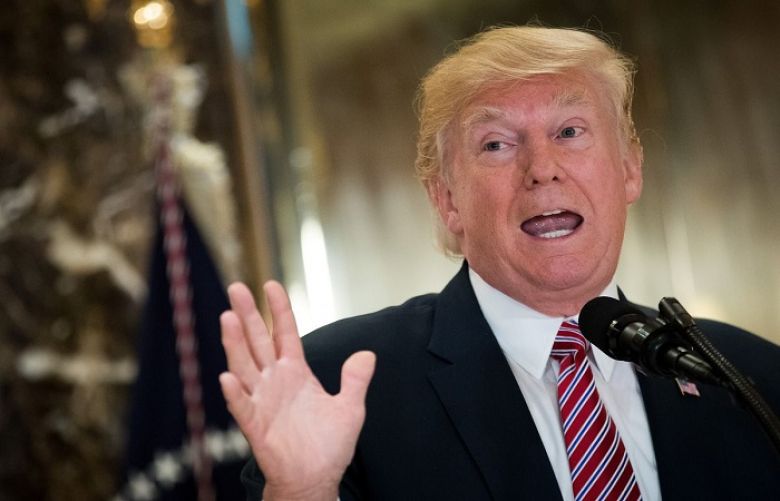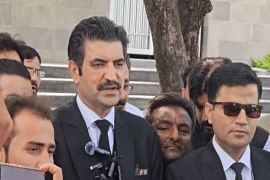President Trump wants to be entirely clear: He blames both sides for the violence in Charlottesville that killed one person and injured dozens.
Despite the prepared statement he read Monday, Trump doesn’t particularly feel that white nationalists were to blame for the violence. He thinks the “alt-left” was charging at marchers with clubs. He thinks a torchlit march in which people did Nazi salutes, chanted, “Sieg heil!” and assaulted counterprotesters was a good example of people “very quietly protesting.” And he thinks the violence distracted from the rally’s laudable aim, to defend a statue of Robert E. Lee.
What Trump said Tuesday, in an unscripted press conference, made explicit all the darkest undertones of his gallingly weak statement from Saturday. In the face of a “Nazified” rally that left an American citizen dead, he muddied the waters (all but lying about what happened over the weekend) and softened his judgment of the march itself.
After Saturday’s statement, white nationalists celebrated Trump’s support for them, while Americans of color worried that they had been abandoned. Tuesday’s remarks are nearly certain to convince both sides they were right.
During Tuesday’s press conference, President Trump proclaimed that he’d been deliberately vague in his initial statement about Charlottesville because he “wanted to make sure, unlike most politicians, that what I said was correct."
Then he proceeded to lie about what happened, muddying the waters about who was really to blame in Charlottesville — and putting forward the idea that the counterprotesters and the marchers bore equal responsibility for what happened:
What about the alt-left that came charging at, as you say, the alt-right, do they have any semblance of guilt? … What about the fact that they came charging with clubs?
I think there is blame on both sides. You look at both sides. I think there is blame object on both sides. I have no doubt about it. You don't have doubt about it either. If you reported it accurately, you would say that.
Trump isn’t the first conservative to argue that because there was some violence initiated by counterprotesters as well as marchers, both sides are equally culpable (or that it’s impossible to tell who was “really” at fault). But the clearest and most comprehensive accounts of Charlottesville over the weekend aren’t so equivocal.
The violence was initiated, on Friday night, by right-wing marchers who assaulted protesters around a statue of Thomas Jefferson. While both counterprotesters and marchers engaged in some throwing of water bottles and rocks on Saturday, the marchers were the ones projecting a military presence and who initiated the bulk of the confrontations. The image Trump evoked, of a mass of counterprotesters “charging with clubs,” is a complete invention.
And the death of Heather Heyer, after a car (suspected to have been driven by march attendee James Alex Fields Jr.) accelerated for several hundred feet before plowing into her and 19 other counterprotesters, was not driven by the “alt-left.”
Of course, all of this is completely separate from the fact that the co-sponsors of the “Unite the Right” march included the white nationalist group Vanguard America (whose shield Fields is holding in one picture taken from the rally) and the National Socialist Movement. It doesn’t address the basic fact that marchers included members of the Ku Klux Klan and neo-Nazis, or that some used the Nazi salute and chanted, “Sieg heil!”
It doesn’t address the fact that many of the marchers at Saturday’s rally were marching to protect white America from the scourge of “diversity” (in some cases, with physical disruption and violence), while the counterprotesters were there to oppose those views (in some cases, with physical disruption and violence).
But Trump refused to acknowledge any empirical or moral difference. To him, it was simply “disruption.” That’s an irresponsible lesson to take from Charlottesville — but a comforting one to any Trump supporter who is convinced there would be no problems in America if “thugs” didn’t start them.
President Trump appeared to believe that “the neo-Nazis and the white nationalists” had hijacked a rally that was supposed to be a peaceful, “very quiet” protest of plans to take down a statue of Robert E. Lee. (He also made it pretty clear that he opposed plans to take down the statue: “You are changing history and culture.”)
The opposite is true. The Unite the Right rally started with a statue, (though its organizer was a self-defined “pro-white” activist), but its trajectory was “increasingly Nazified” before last weekend, as groups like the National Socialist Movement got on board and non-white-nationalist “patriot” groups dropped out. The Unite the Right rally showed that there was little appetite among those protesting the removal of the Lee statue to distinguish themselves from the white nationalists.
And Donald Trump, time and time again, sends messages to both groups that he shares their vision of America and their concerns for its future.
When Trump says that removing Lee’s statue is “changing history and culture,” he’s echoing not only the rhetoric of those who believe the Confederacy is part of the “heritage” of the South (ignoring the millions of Southerners who are the descendants of the slaves that people like Lee owned and fought to keep); he’s echoing the fears of white nationalists who believe that America is supposed to be a white nation, and that “diversity” and “political correctness” are erasing both America’s past and its future. When he compares Robert E. Lee to George Washington, he’s sure to thrill the hearts of people who believe the Confederacy was morally right to secede from the United States of America, and that the horrors of slavery are overblown at best.
When he insists that the Friday night torchlit march (which featured the “Sieg heil!” chants) was quiet and peaceful, he’s not just wrong. He is, in every way, legitimizing the ideologies those marchers expressed as good and orderly.
There are millions of Americans who have lived in fear of a resurgent white supremacism since before Trump’s election. He has never offered them any form of reassurance. The closest he has come — during his inauguration and again Saturday — was that as long as all sides put aside their distrust of each other, America will be made great again. At best, he tells them that their fear is their problem, an obstacle to overcome.
At worst, he tells them that they provoked lethal violence against themselves — that there wasn’t anything wrong with the Charlottesville rally until some people came “charging with clubs.”
President Trump pays less lip service than any politician in recent memory to the idea that he has to govern for all Americans equally, whether or not they voted for him in 2016 or support him now. If on Monday he briefly offered a gesture of protection to the Americans who worry he’s encouraging hate and violence, he’s now turned that gesture into an upturned middle finger. President Trump is all but offering succor to the marchers. He is denying comfort to those who heard the “quiet” chants on Friday night and had to tuck in their children, and lock their doors, a little tighter.







